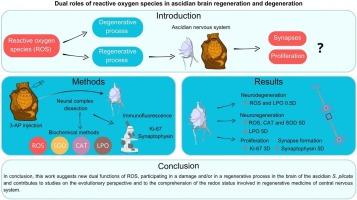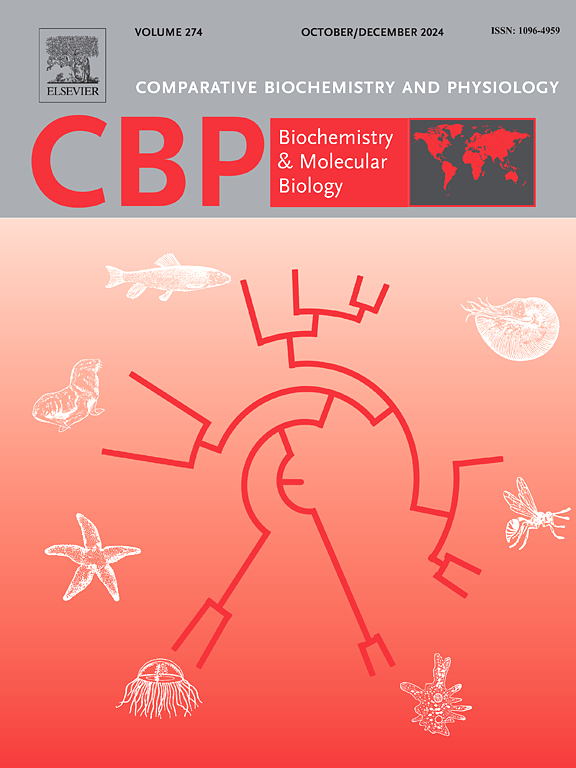活性氧在海鞘脑再生和退化中的双重作用
IF 1.8
3区 生物学
Q4 BIOCHEMISTRY & MOLECULAR BIOLOGY
Comparative Biochemistry and Physiology B-Biochemistry & Molecular Biology
Pub Date : 2025-08-23
DOI:10.1016/j.cbpb.2025.111150
引用次数: 0
摘要
活性氧(ROS)是由神经细胞代谢产生的,对维持细胞稳态至关重要。由于神经系统的高代谢活动和氧气消耗,产生大量ROS。虽然传统上认为活性氧与氧化应激和变性有关,但最近的研究表明,它们也可能在神经修复中发挥有益作用。为了探讨活性氧在中枢神经系统(CNS)再生中的作用,我们以能在10天内再生全脑的成体海鞘(ascidian Styela plicata)为模型。我们旨在阐明ROS和抗氧化酶超氧化物歧化酶(SOD)和过氧化氢酶(CAT)在神经毒素3-乙酰吡啶(3-AP)全身注射后,在皱襞海鞘中枢神经系统突触形成和/或细胞增殖中的作用。数据显示两个不同的高ROS产生时期:0.5天和5天。SOD和CAT活性仅在第5天升高。脂质过氧化在0.5 d时最高,在注射后10 d监测期内逐渐降低。增殖标志物Ki-67和突触标志物synaptophysin分别在第3天和第5天升高。这些发现表明ROS具有双重作用:早期与神经退行性变有关,晚期与再生有关。这突出了氧化还原信号在中枢神经系统再生中的复杂作用。本文章由计算机程序翻译,如有差异,请以英文原文为准。

Dual roles of reactive oxygen species in ascidian brain regeneration and degeneration
Reactive oxygen species (ROS) are metabolically generated by neural cells and are essential for maintaining cellular homeostasis. Due to the high metabolic activity and oxygen consumption of the nervous system, large amounts of ROS are produced. Although ROS are traditionally associated with oxidative stress and degeneration, recent studies suggest that they may also play a beneficial role in neural repair. To explore the role of ROS in central nervous system (CNS) regeneration, we employed the adult ascidian Styela plicata, which can regenerate its entire brain within 10 days, as a model. We aimed to elucidate the functions of ROS and the antioxidant enzymes superoxide dismutase (SOD) and catalase (CAT) in the formation of synapses and/or cell proliferation in the CNS of the ascidian S. plicata following the systemic injection of the neurotoxin 3-acetylpyridine (3-AP). The data revealed two distinct periods of high ROS production: at 0.5 and 5 days. SOD and CAT activity increased only at 5 days. Lipid peroxidation was highest at 0.5 days and gradually decreased during the 10 day post-injection monitoring period. The proliferation marker Ki-67 and the synapse marker synaptophysin were elevated at 3 and 5 days, respectively. These findings suggest a dual role for ROS: an early phase linked to neurodegeneration and a later phase associated with regeneration. This highlights the complex role of redox signaling in CNS regeneration.
求助全文
通过发布文献求助,成功后即可免费获取论文全文。
去求助
来源期刊
CiteScore
4.60
自引率
4.50%
发文量
77
审稿时长
22 days
期刊介绍:
Comparative Biochemistry & Physiology (CBP) publishes papers in comparative, environmental and evolutionary physiology.
Part B: Biochemical and Molecular Biology (CBPB), focuses on biochemical physiology, primarily bioenergetics/energy metabolism, cell biology, cellular stress responses, enzymology, intermediary metabolism, macromolecular structure and function, gene regulation, evolutionary genetics. Most studies focus on biochemical or molecular analyses that have clear ramifications for physiological processes.

 求助内容:
求助内容: 应助结果提醒方式:
应助结果提醒方式:


